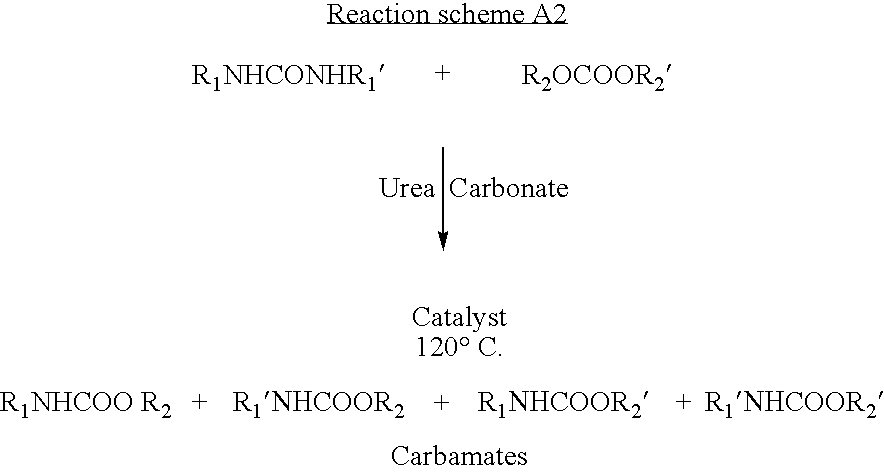Process for preparing carbamates
a carbamate and process technology, applied in the preparation of carbamate derivatives, organic compound preparation, organic chemistry, etc., can solve the problem of not being able to disclose prior art known to applicants, and achieve the effect of simple and inexpensive, stable and recyclable, and not corroding or hazardous
- Summary
- Abstract
- Description
- Claims
- Application Information
AI Technical Summary
Benefits of technology
Problems solved by technology
Method used
Image
Examples
example-1
[0048] 3.16×10″3 mol of N,N′ diphenyl urea, 15.56×103 mol diphenyl dicarbonate and 200 mg HaO (W. R. Grace make silica gel) catalyst were charged to a well flushed and dried 3-necked round bottom reaction vessel (50 cc) equipped with a thermometer, stirrer and reflux condenser. The contents were heated under stirring up to 150° C. and kept for 8 hours while inert atmosphere was maintained. After cooling to room temperature the solid mass was dissolved in acetone, filtered to separate the catalyst and reaction crude. N-phenyl phenyl carbamate was isolated in pure form by column chromatography (silica gel, ethyl acetate-chloroform 0.2:9.8) and characterized by elemental analysis, 1H NMR, 13C NMR, IR. Products and unconverted reactants were analyzed by liquid chromatography (LC) for conversion of N,N′ diphenyl urea and organic dicarbonate and selectivity to carbamate. Urea being the limiting reactant in this case conversion of urea was calculated on the basis of moles of urea consumed ...
example-2
[0049] The procedure in example-1 was exactly repeated except that the catalyst, which was recovered as shown in Exmple-1, was washed with acetone and dried at 100° C. for six hours and was charged to the reactor along with 3.16×10˜3 mol N,N′diphenyl urea, 15.56×10″3 mol diphenyl carbonate. After cooling to room temperature the LC analysis of reaction crude showed 78% diphenyl urea conversion and selectivity to N-phenyl phenyl carbamate to be 98%.
example-3
[0050] The procedure in example-1 was exactly repeated except that for the charge 3.16×10″3 mol N,N′diphenyl urea, 15.56×10′3 mol diphenyl carbonate and recovered catalyst of Example-2, was washed with acetone and dried at 100° C. for six hours and was charged to the reactor.
[0051] After cooling to room temperature the LC analysis of reaction crude showed 79% diphenyl urea conversion and selectivity to N-phenyl phenyl carbamate to be 98%.
PUM
| Property | Measurement | Unit |
|---|---|---|
| temperature | aaaaa | aaaaa |
| temperatures | aaaaa | aaaaa |
| temperatures | aaaaa | aaaaa |
Abstract
Description
Claims
Application Information
 Login to View More
Login to View More - R&D
- Intellectual Property
- Life Sciences
- Materials
- Tech Scout
- Unparalleled Data Quality
- Higher Quality Content
- 60% Fewer Hallucinations
Browse by: Latest US Patents, China's latest patents, Technical Efficacy Thesaurus, Application Domain, Technology Topic, Popular Technical Reports.
© 2025 PatSnap. All rights reserved.Legal|Privacy policy|Modern Slavery Act Transparency Statement|Sitemap|About US| Contact US: help@patsnap.com


